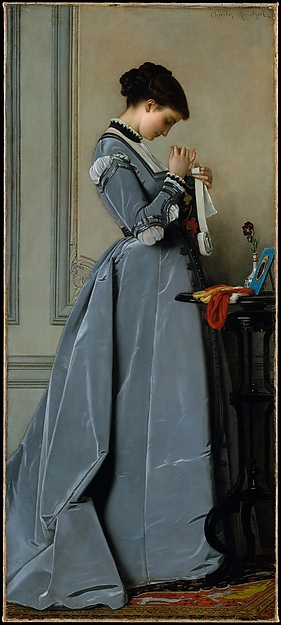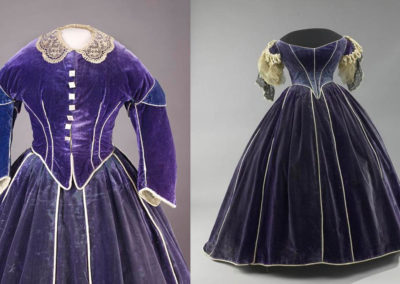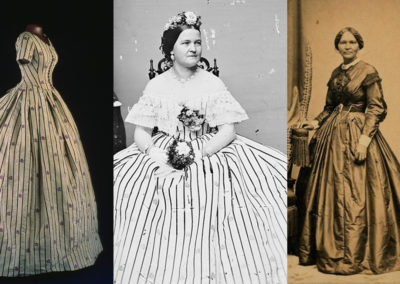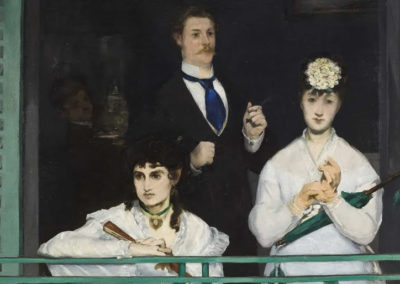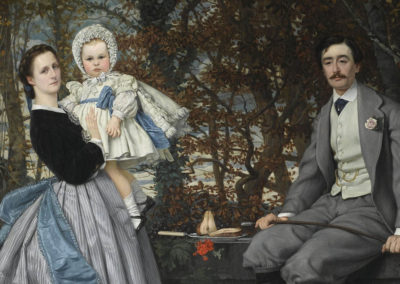OVERVIEW
In 1868, skirts with long trains were at the height of fashion, which resulted in noticeable cropping in images depicting this prevalent style of dress. Yet, at the same time, walking dresses became daringly short, showing off fashionable ankle boots.
In 1868, The New York Times outlined the development of dress and accessories in an article titled “Visiting and Evening Dresses“:
“One thing only is indispensable, and that is, a train. Provided the train is long, and the skirt narrow, the rest of the dress may be left to Providence. Only ignorant women or vulgar now wear crinoline so that it can be detected. Sashes have become the most important accessory of the toilette. No dress is complete without them.”
In January 1868, a “New York Fashions” column published in Harper’s Bazar describes the trained skirt with more details:
“The long, full-trained skirt is plain about the hips and front, but is gathered at the back in several rows of French gathers. The front width is cut off at the knee and finished by a wide flounce set on in box pleats… There are two waists to this dress – a plain high corsage with flowing sleeves, and a low round waist with a bertha of folds and short puffed sleeves.” (163)
The two quotations have clearly described the silhouette of dresses in 1868. It is thus not surprising to see artists cropping the edge of dresses in their paintings (Fig. 1) because of the long trains.
Fig. 1 - Charles-François Marchal (French, 1825–1877). Penelope, ca. 1868. Oil on canvas; 110.5 x 49.5 cm (43 1/2 x 19 1/2 in). New York: Metropolitan Museum of Art, 17.138.2. Gift of Mrs. Adolf Obrig, in memory of her husband, 1917. Source: Metropolitan Museum of Art
Fig. 2 - Pierre-Auguste Renoir (French, 1841-1919). A Couple (Les Fiancés), ca. 1868. Oil on canvas; 105 x 75 cm. Köln: Wallraf-Richartz Museum, Inv. no. WRM 1199. Source: Wallraf-Richartz Museum
Fig. 3 - Artist unknown (French). La Mode illustrée, May 1868. Source: Google Books
A Couple by Auguste Renoir (Fig. 2) could capture the viewer’s eyes at once for the vivid colour with stripes on the walking dress. In the July “Novelties for the Month” column in Peterson’s Magazine, it introduces two striped walking dresses, thus I assume her stripe dress is a popular style in that month of the year. The lace sleeve shows her fashion taste also for “…well-shaped arms were mid-nineteenth century advantages, and were shown to great effect in the striped and point d’esprit versions of the sheer yoke and sleeve” (Fashion: A Timeline in Photographs: 1850 to today, 2015). In addition, her hairstyle echoes the trendy hairstyle in the July column of La Mode illustrée (Fig. 3). The vibrant yellow and orange colors are likely achieved using aniline dyes, synthetic dyes that were extremely popular ever since their introduction in the late 1850s. See another bright aniline dye dress in green in figure 6 below. All in all, her wardrobe is fashionable for 1868.
Fig. 4 - Artist unknown (French). Les Modes Parisiennes, 1868. Source: Google Books
Fig. 5 - Artist unknown (French). Fashion plate, November 1868. New York: Metropolitan Museum of Art, b17520939. Gift of Woodman Thompson. Source: Watson Library at the Metropolitan Museum of Art
Besides the popularity of long or trained dresses, walking suits that normally include a skirt and a paletot (or jacket), become a fashion during this period of time as well. The waist of a paletot could either hang loosely or be close-fitted with a belt. The seated woman in a January 1868 Les Modes Parisiennes fashion plate (Fig. 4) wears a red paletot. Note that some walking suits featured quite short hems (Fig. 5) that revealed short ankle boots to the passer-by.
Fig. 6 - Designer unknown (American). Dress, 1868. Silk. New York: Metropolitan Museum of Art, C.I.53.72.1a–c. Gift of Mrs. William R. Witherell, 1953. Source: Metropolitan Museum of Art
Fig. 7 - Designer unknown. Ball gown, ca. 1868. Champagne-colored silk gros de tours with black machine chantilly lace. Den Haag, Netherlands: Gemeentemuseum den Haag. Source: Pinterest
Fig. 8 - Designer unknown (French). Ball gown, ca. 1868. Silk. New York: Metropolitan Museum of Art, C.I.69.14.1a, b. Gift of Mary Pierrepont Beckwith, 1969. Source: Metropolitan Museum of Art
Eily H.May indicates some changes in the length of dress. In November column of “Novelties for the Month” in Peterson’s Magazine she writes:
“For young ladies who dance, short dresses will be worn quite as much as those with trains; and we certainly think the fashion a sensible one; but care should be taken not to have the dresses too short, as then the feet would be indelicately exposed.” (379)
For two 1868 ball gowns suitable for dancing with moderate trains, see figures 7 & 8.
The sale of ready-made dress for ladies is in its beginning stage at this point, while gentlemen are familiar with buying ready-made clothing as the sack suit did not require the precise tailoring of earlier suit styles (Figs. 9, 10); however, the choices become more and more wide and so too the price range.
There are few changes for children’s wear in 1868. Most of the styles are adapted from adults’ styles directly (Figs. 11, 12).
Fig. 9 - Artist unknown. Gazette of fashion, and cutting-room companion, January 1868, Vol. 22. Source: Google Books
Fig. 10 - William James Topley (Canadian, 1845-1930). A.M. Ross, April 1868. Photograph; (3.25 x 4.25 in). Ottawa: Library and Archives Canada, 1936-270 NPC. Source: Library and Archives Canada
Fig. 11 - Ludwig Angerer (Austrian, (1827-1879)). Wien, 1868. Photograph. Source: Pinterest
Fig. 12 - Designer unknown (French). Child's dress, 1868. Wool, silk. New York: Metropolitan Museum of Art, C.I.56.43. Gift of A. Hyatt Mayor, 1956. Source: Metropolitan Museum of Art
References:
- “1868.” Wikipedia. Accessed February 3, 2017. https://en.wikipedia.org/wiki/1868
- Milbank, Caroline Rennolds, and Harold Koda. 2015. Fashion: A Timeline in Photographs: 1850 to Today. New York: Rizzoli International Publications, Inc. http://www.worldcat.org/oclc/905518225.
- “New York Fashions.” Harper’s Bazar I, no. 11 (January 11, 1868): 163. http://hearth.library.cornell.edu/h/hearth/browse/title/4732809.html#1868
- “Novelties for the Month.” The Peterson Magazine, Vol. 53-54, (October, 1868): 379. https://books.google.com/books?id=zcU6AQAAMAAJ
- “Visiting and Evening Dresses.” New York Times (March 26, 1868). http://query.nytimes.com/gst/abstract.html?res=9807E5DE1730EE34BC4E51DFB5668383679FDE&url=http:%2F%2Ftimesmachine.nytimes.com%2Ftimesmachine%2F1868%2F03%2F26%2F78911224.html&legacy=true
Historical Context
Wikipedia: 1868
Rulers:
- America: President Andrew Johnson (1865-69)
- England: Queen Victoria (1837-1901)
- France: Emperor Napoleon III (1852-70)
- Spain
- Queen Isabel II (1833-68)
- Regent Francisco Serrano y Domínguez (1868-71)

Europe in 1867. Source: Omniatlas
Events:
- Creation of the Chambre Syndicale des Confectionneurs et des Tailleurs pour Dames, the first union for seamstresses and dressmakers. In 1910 it will become the Chambre Syndicale de la Couture Parisienne. (IFM 274)
- In Chicago, Field, Leiter and Co. opens in a six-story building at the northeast corner of State and Washington Streets. It will become Marshall Field and Co. in 1881 and will remain Marshall Field’s until the firm’s acquisition by Macy’s, Inc., in 2005. (IFM 274)
- Emergence of new technological developments in the manufacture of corsets, such as the steam-molding process. (IFM 274)
- March – The first transnational women’s organization, Association internationale des femmes, is founded.
- May 16, May 26 – President Andrew Johnson is twice acquitted during his impeachmenttrial, by one vote in the United States Senate.
- September – Glorious Revolution: Queen Isabella II of Spain is effectively deposed and sent into exile; she formally abdicates on June 25, 1870.
Timeline Entries
Primary/Period Sources
Resources for Fashion History Research
To discover primary/period sources, explore the categories below.
Have a primary source to suggest? Or a newly digitized periodical/book to announce? Contact us!
Fashion Plate Collections (Digitized)
- Costume Institute Fashion Plate collection
- Casey Fashion Plates (LA Public Library) - search for the year that interests you
- New York Public Library:
NYC-Area Special Collections of Fashion Periodicals/Plates
- FIT Special Collections (to make an appointment, click here)
- Englishwoman's Domestic Magazine (London: 1852-79), 1860-64, 1867-69 (TT500 .E6)
- Costume Institute/Watson Library @ the Met (register here)
- New York Public Library
- Brooklyn Museum Library (email for access)
Womenswear Periodicals (Digitized)
Etiquette Books (Digitized)
Menswear Periodicals (Digitized)
Secondary Sources
Also see the 19th-century overview page for more research sources... or browse our Zotero library.


